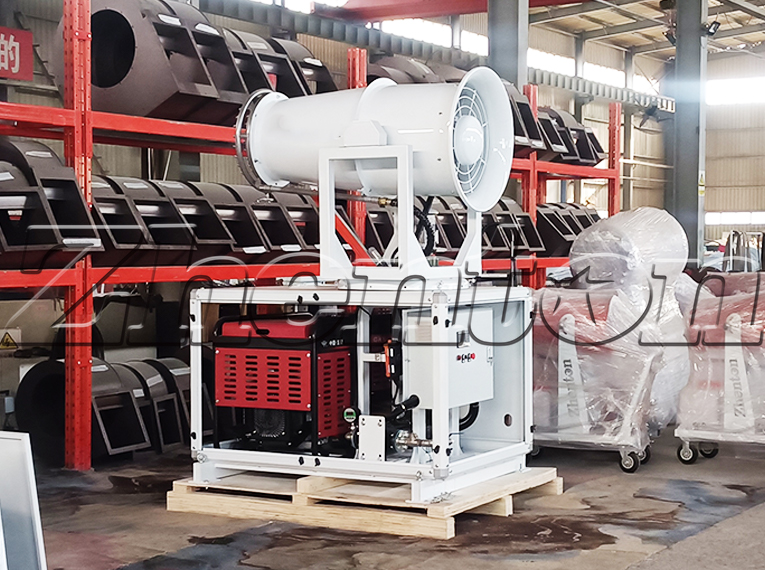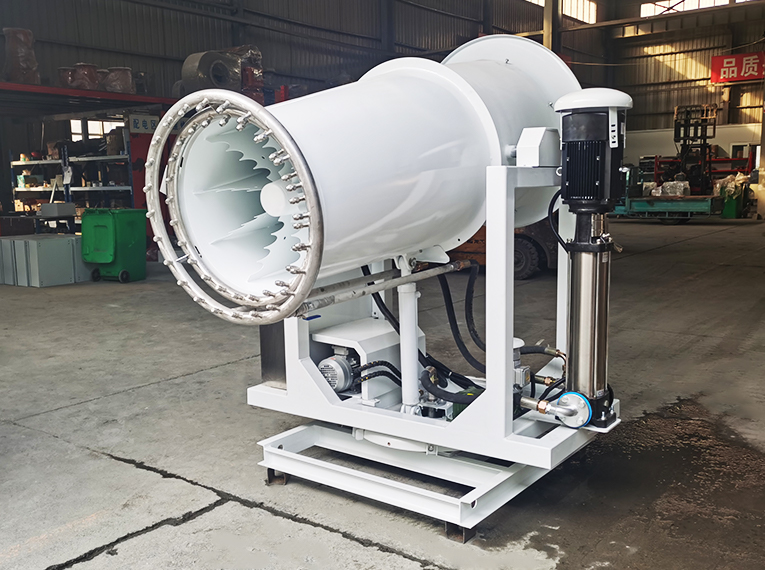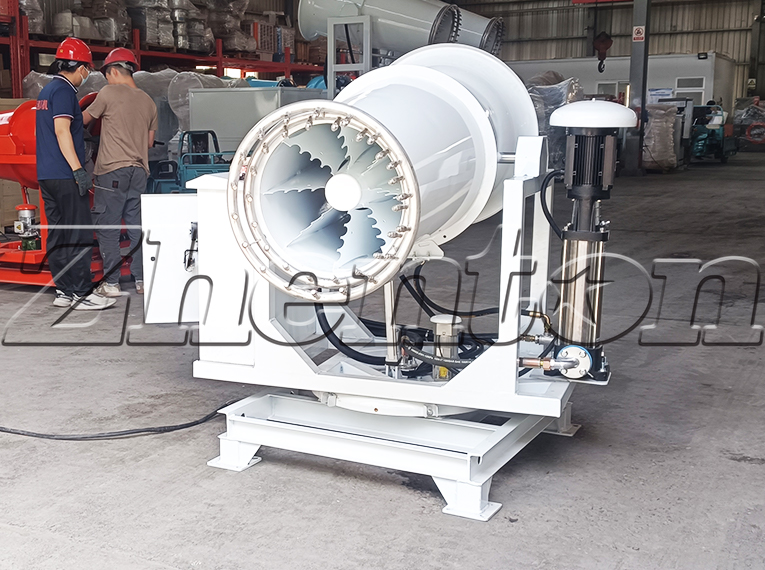Dust pollution in open-air material yards for coal, ore, and construction materials not only threatens operational safety but also poses a critical compliance risk under strict environmental inspections. How to accurately select a fog cannon machine that balances dust control efficiency with cost control? Drawing on industry data and the latest environmental policies, this article breaks down the core selection logic and price composition to help you avoid common pitfalls in equipment procurement.
Four Key Selection Factors: Matching Equipment Parameters to Operational Needs
1. Yard Size Dictates Basic Configuration
Small Yards (<50,000㎡)
Recommend fog cannon machines with a 50–80m spraying range, such as the TDM-60 model, which covers a 60m radius in still wind and can handle 3,000㎡ of frequent dust control. A county-level sand yard achieved full-yard coverage in 8 hours daily with a 10-ton water truck, boosting dust control efficiency by 40% compared to traditional sprinklers.
Medium Yards (50,000–200,000㎡)
Opt for 80–120m range fog cannon machines like the TDM-100 with dual fans and aviation-grade aerodynamic design, covering 15,000㎡ per hour. At a Hebei steel raw material yard, 3 units reduced PM10 from 5.8mg/m³ to 1.2mg/m³ in 3 hours through targeted dust control.
Large Yards (>200,000㎡)
Deploy 120–150m ultra-long-range fog cannon machines integrated with intelligent networking and PLC central control. A Shenhua open-pit coal mine used 5 such units to achieve comprehensive dust control across 500,000㎡ in 15 minutes, increasing efficiency by 35% over single-machine operation.
2. Dust Characteristics Determine Technical Solutions
Fine Particles (Coal Powder, Fly Ash)
Require 20–50μm ultra-fine atomization for Brownian motion adsorption, the key to effective dust control for micro-pollutants. Choose models with ceramic atomization cores (uniformity error ≤±3%), extending nozzle life by 20% compared to stainless steel.
Coarse Particles (Crushed Ore)
Use 50–150μm droplet sizes for gravitational sedimentation, ideal for heavy dust control in mining scenarios. A Shandong gold mine’s high-pressure swirl nozzle fog cannon machine achieved 92% capture efficiency for 50–100μm particles, 55% higher than traditional low-pressure nozzles.
Hygroscopic Materials (Cement, Gypsum)
Equip with humidity sensors for automatic "pulse spraying" to prevent material caking during dust control. A Jiangsu concrete plant stabilized moisture content within ±1.5% using this feature, reducing annual material loss by 120 tons.
3. Intelligence Enhances Long-Term Value
Basic Model (Manual Control)
Suitable for fixed workpoints with manual angle adjustment, offering cost-effective dust control for budget-sensitive small and medium yards like rural construction material sites.
Smart Model (PLC + Remote Control)
Supports dust concentration sensor linkage (optional) and GPS route planning, enabling precise dust control for large enterprises with cross-regional operations.
Unmanned Model (AI + 5G)
Features visual obstacle avoidance and full-process APP monitoring, providing advanced dust control solutions for high-risk environments like chemical material yards.
4. Environmental Adaptability Impacts Lifespan
Extreme Cold (<-20℃)
Choose models with low-temperature hydraulic systems and electric water tank heaters to ensure reliable dust control in harsh winters. A Northeast coal terminal’s frost-resistant fog cannon machines reduced winter failure rates by 70%.
High Temperature & Humidity
Prioritize 304 stainless steel bodies with anti-corrosion coatings and cooled motors to maintain consistent dust control performance. A Guangdong port yard’s corrosion-resistant fog cannon machines lasted 3+ years longer than standard models.
Windy Areas (Annual Wind Speed >6m/s)
Require wind-speed compensation algorithms to adjust spraying angles in real time, ensuring effective dust control even in 8-level winds. An Xinjiang open-pit mine’s wind-resistant fog cannon machines maintained 60m effective range in challenging conditions.

Price Analysis: What Drives the 80K–500K RMB Cost Difference?
1. Core Configurations Define Base Prices
Configuration Level | Spraying Range (m) | Atomization System | Control System | Price (10K RMB) | Application Scenarios |
Economic | 50–60 | Copper Nozzles | Manual/Remote | 0.5–1.5 | Small yards, temporary dust control |
Standard | 80–100 | Stainless Steel Nozzles | PLC Control | 15–5-10 | Medium yards, port dust control |
Premium | 120–150 | Ceramic Atomization Core | AI System | 10-30 | Large mines, steel yard dust control |
2. Hidden Costs Affect Real-World Value
Energy Consumption
Standard models consume 15–20L/hour, while energy-efficient inverters reduce this to 8–12L/hour—saving ~25K RMB annually for 2,000 hours of dust control operations.
Maintenance Costs
Stainless steel nozzles need replacement every 6 months vs. 18 months for ceramic ones, creating a 12K RMB annual cost gap in dust control equipment upkeep.
Policy Incentives
New-energy (electric/hybrid) fog cannon machines qualify for 15–20% government subsidies, directly lowering the total cost of dust control solutions. A Shandong enterprise saved 90K RMB on 3 electric units, reducing effective cost by 18%.
3. Low-Price Pitfalls to Avoid
False Range Claims
Some budget models advertise 80m range but deliver only 50m in real tests—always verify with third-party dust control performance reports.
Material Cutting
Carbon steel replacements for stainless steel lead to >30% rusting within a year, undermining the reliability of dust control equipment and increasing long-term costs.
Control System Omissions
Models without overload protection risk motor burnout, highlighting the importance of CE and ISO9001 certifications for safe dust control operations.
Practical Cases: Optimal Solutions for Different Yard Sizes
Case 1: Henan Construction Sand Yard (100,000㎡)
Challenge: Severe dust diffusion causing PM10 超标 (exceeding standards), requiring efficient dust control.
Solution: 2 standard 80m fog cannon machines with 15-ton water trucks, achieving comprehensive dust control coverage.
Cost: 280K RMB total, reducing annual dust control chemical costs by 40% and avoiding 150K RMB in environmental fines.
Case 2: Inner Mongolia Coal Logistics Park (500,000㎡)
Challenge: High winter failure rates in low-temperature, windy conditions, demanding robust dust control solutions.
Solution: 4 wind-resistant 120m fog cannon machines (with heaters) connected to a smart environmental platform, ensuring year-round dust control efficiency.
Cost: 1.6M RMB total, saving 350K RMB annually in labor scheduling costs and extending equipment lifespan by 25%.
Procurement Tips to Avoid Pitfalls
On-Site Testing
Require manufacturers to demonstrate effective dust control coverage under real wind conditions at your yard to validate performance claims.
Spare Parts Clarity
Confirm warranty periods and supply cycles for vulnerable components (nozzles, filters) to ensure uninterrupted dust control operations and avoid unexpected expenses.
Service Network Priority
Choose brands with local after-sales centers and 24-hour response guarantees, significantly improving fault resolution efficiency for continuous dust control.

Conclusion: The Right Fog Cannon Machine Cuts Dust Control Costs by 30%
Dust management in open-air yards is a strategic balance between technical innovation and cost efficiency. By matching yard size, dust characteristics, and environmental conditions with intelligent fog cannon machine configurations—and avoiding low-quality traps—you can achieve "one-time investment, long-term operational stability." Under current environmental policies, compliant fog cannon machines are not just dust control tools but essential assets for sustainable operations and regulatory compliance. Contact our experts today for a customized dust control solution—transform every investment into enhanced environmental and operational performance.











